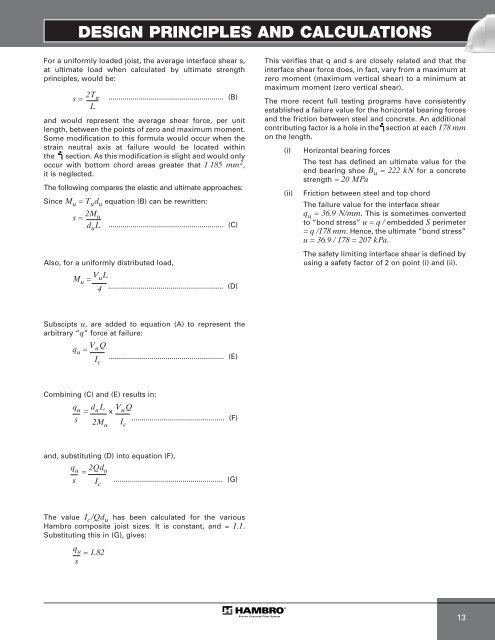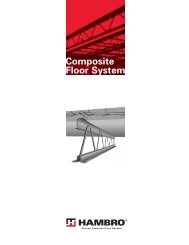MEP-Technical Manual CDN 0408.qxd - Hambro
MEP-Technical Manual CDN 0408.qxd - Hambro
MEP-Technical Manual CDN 0408.qxd - Hambro
Create successful ePaper yourself
Turn your PDF publications into a flip-book with our unique Google optimized e-Paper software.
DESIGN PRINCIPLES AND CALCULATIONS<br />
For a uniformly loaded joist, the average interface shear s,<br />
at ultimate load when calculated by ultimate strength<br />
principles, would be:<br />
s = 2T u<br />
L<br />
......................................................... (B)<br />
and would represent the average shear force, per unit<br />
length, between the points of zero and maximum moment.<br />
Some modification to this formula would occur when the<br />
strain neutral axis at failure would be located within<br />
the section. As this modification is slight and would only<br />
occur with bottom chord areas greater that 1 185 mm 2 ,<br />
it is neglected.<br />
The following compares the elastic and ultimate approaches:<br />
Since M u = T u d u equation (B) can be rewritten:<br />
s = 2M u<br />
d u L<br />
......................................................... (C)<br />
Also, for a uniformly distributed load,<br />
Mu =<br />
......................................................... (D)<br />
VuL 4<br />
Subscipts u, are added to equation (A) to represent the<br />
arbitrary “q” force at failure:<br />
q u = V u Q<br />
I c<br />
Combining (C) and (E) results in:<br />
q u = d u L x V u Q<br />
s<br />
2M u<br />
......................................................... (E)<br />
and, substituting (D) into equation (F),<br />
q u = 2Qd u<br />
s<br />
I c<br />
I c<br />
.............................................. (F)<br />
...................................................... (G)<br />
The value I c /Qd u has been calculated for the various<br />
<strong>Hambro</strong> composite joist sizes. It is constant, and = 1.1.<br />
Substituting this in (G), gives:<br />
qu = 1.82<br />
s<br />
This verifies that q and s are closely related and that the<br />
interface shear force does, in fact, vary from a maximum at<br />
zero moment (maximum vertical shear) to a minimum at<br />
maximum moment (zero vertical shear).<br />
The more recent full testing programs have consistently<br />
established a failure value for the horizontal bearing forces<br />
and the friction between steel and concrete. An additional<br />
contributing factor is a hole in the section at each 178 mm<br />
on the length.<br />
(i) Horizontal bearing forces<br />
The test has defined an ultimate value for the<br />
end bearing shoe Bu = 222 kN for a concrete<br />
strength = 20 MPa<br />
(ii) Friction between steel and top chord<br />
The failure value for the interface shear<br />
qu = 36.9 N/mm. This is sometimes converted<br />
to “bond stress” u = q / embedded S perimeter<br />
= q /178 mm. Hence, the ultimate “bond stress”<br />
u = 36.9 / 178 = 207 kPa.<br />
The safety limiting interface shear is defined by<br />
using a safety factor of 2 on point (i) and (ii).<br />
13



